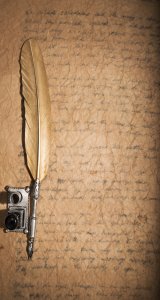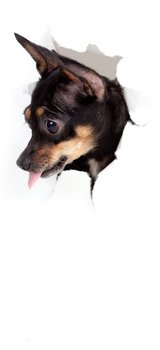Taking Panoramic Landscapes - The Easy Solution
I love panoramas. There's something very appealing about their shape. It's probably because we see the world more in these dimensions than the near square format of standard film/sensor frames. It might also explain the upsurge in the popularity of widescreen TVs!
Panoramas have a reputation of being hard to take. There are dedicated panorama cameras available but unless you've got at least a thousand dollars to spare, you probably can't afford one! But you can take panoramas with any kind of camera.
All a panorama is, is a sequence of images where you turn slightly for each different frame. In the old days, before PCs and the likes of Photoshop were around, you'd take your prints (there wasn't much point in shooting panoramas on slide film, for obvious reasons), lay them out on a table and position them over each other where they overlapped. A bit of sticky tape held them together. [As a side note, this technique was used by NASA to build up mosaic pictures of the planets and satellites their spaceprobes visited, up till the late '70s/early 80s when computers were introduced to make the process less laborious].
Now that PCs and image manipulation packages are easy to come by, high-quality panoramas can now be created by anyone. If you're shooting slide or negative film, you will need to have your images scanned before you do anything else.
DIY Panoramas
The idea behind taking panoramas with SLR cameras is that the camera is rotated around its nodal point during each successive exposure. What's the Nodal Point? It's the point inside your camera where the light rays converge and flip over. It's different for different focal lengths (on zoom lenses) and for different prime lenses (fixed focal length lenses like a standard 50mm lens). It's important to rotate about this point to eliminate image mismatches due to changes in parallax. Parallax is the apparent shift of an object against a background due to a change in observer position.
Just to be clear, the Nodal Point is not the same as the film/sensor plane. Generally, for most SLR cameras and lenses, the Nodal Point is located somewhere towards the center of the lens barrel and lies in front of the image/sensor plane.
The Problem With Parallax
Parallax is easily demonstrated by a simple experiment. Hold up your finger about 1 foot in front of your face and alternately open and close your left and right eyes. You'll notice that your finger shifts left and right with respect to the background depending on which eye is open. Try another experiment: With your finger still raised, close one eye and turn your head from side to side. Notice how your finger moves with respect to the background. This relative movement is due to the fact that you're not rotating your head around your eye's nodal point, which is somewhere in the center of your eyeball. Instead, you're rotating about your spine which is several inches to the rear and off to one side. It is this relative side-to-side motion that we try to eliminate when setting up a camera for panoramas. [If you want to read up more about parallax, Wikipedia have a good explanatory article.]
Now, if you consider a camera held up to your face - it will suffer even greater parallax errors as it's farther from your spine (the point of rotation of your head) than your eye. It's surprisingly common for people to take panoramas in this fashion and then find the individual pictures don't match up.
So use a tripod and rotate the camera on the tripod. The parallax errors will be significantly smaller but there will still be some error involved. However, the images will match up better than with the head rotation method.
Mechanical Contraptions
What perfectionists strive for is to have the camera rotate about the nodal point. There are brackets and contraptions available that will let you offset your camera from the tripod's axis of rotation and with a little experimentation and trial and error, you can position your camera so that its nodal point is directly over the axis of rotation of the bracket. Getting this spot-on means your images should line up perfectly.
A few months ago I bought such a bracket - the Kaidan Kiwi. This comes in two halves which produce an L-shaped bracket. Its instruction manual explains how to set it up and find the nodal point for your camera and lens. However, you have to get your tripod perfectly level before using it, otherwise you end up with a curved panorama rather than a straight one.
I've had good success using this bracket, but it is large and heavy and certainly a bit too cumbersome to be carrying on long walks or while away on vacation.
AutoStitch To The Rescue
Then I recently came across a free bit of software called AutoStitch. Written by a couple of students at the University of Columbia, this takes all of the heartache out of creating panoramas. All you do is select the size of the final image and tell it what images you want it to stitch. It then goes off and produces your panorama.
It really is that simple. Unless successive images are radically different in exposure (i.e. one image to too light or dark compared to another), it seamlessly blends them. It performs all the warping of the images necessary to get them to align (other software I've used can cause ghosting in the overlap areas where it hasn't quite aligned the images). It also aligns multiple rows of images rather than just a single strip.
Even better, it doesn't require you to set up your camera to rotate about its nodal point. When I was in Crete last year, I tried shooting a few panoramas with my Canon EOS 300D held up to my eye (I didn't have a tripod with me). When I got home, I tried stitching the pictures together using various bits of software (including software dedicated to stitching images together) and didn't get satisfactory results. I knew, though, that it was because I'd swivelled the camera about my spine. But I tried these images with AutoStitch and they came out perfectly. See for yourself here.
I went walking up the Wicklow mountains in Ireland no too long ago and up to a high point called Djouce which offers a view over the rolling hills south of Dublin. As an experiment, I shot 8 frames while rotating my head about the scene (camera to eye as per normal). I wanted to see if the Crete photos were a fluke as the panoramas from there were composed of, at most, 3 frames each (sometimes 2).
Conclusion
What can I say? I plugged 8 frames into AutoStitch and after a bit of time processing the images, it produced a perfect panorama with no ghosting I could see in the overlap reasons. I like software like that. It may only do one thing but it does that one thing very well.
Give AutoStitch a try. It's free and, so far, it produces the best panoramic results of all the panorama/stitching software I've tried.
One thing to remember when taking panoramas is that the exposures of each frame should be the same. So if you make your first exposure at f/8 and 1/125 of a second, take them all using those settings. Yes, you will have to put your camera into manual mode. Otherwise, you run the risk of having radically different exposures for your images. For example, if you're panning over a landscape that contains water, like a lake, any sunlight reflected off the water may make your camera take a shorter exposure than for the other frames in your sequence. Setting your camera to manual mode will prevent that.
Gary Nugent is a software engineer by profession and has been in the business for over 20 years. Photography has been a hobby for an even longer period of time and he's now even more passionate about it since making the switch to using a digital SLR camera. He runs the Great Landscape Photography website: http://www.great-landscape-photography.com
|
|
|
|
|
|
|
|
|
|
|


Digital Photography: The RAW vs JPG Debate
If you use a digital camera (I use a Canon... Read More
The Primer on Digital Camera Printers
Once you have clicked photos through your digital camera, then... Read More
The Truth About Pixels, Part 2-1: Printing 4x3 Inch Photos
Why is a 3 megapixel camera better than a 1... Read More
Transfer The Digital Camera Images To Your Computer
There are a few very important tasks associated with using... Read More
How to take Great Photos of Your Pet
We all love our animals. They do such funny, adorable,... Read More
Start Your Own Photography Business from Home
Anyone with the right camera equipment, and the necessary skills... Read More
How To Avoid Or Reduce Red-Eye
Photography with the aid of a digital camera is beyond... Read More
Making Money With Digital Photography And Live Events
A few years ago I became interested in digital photography,... Read More
10 Steps to Buying a Digital Camera You Must Know
You are anxious to purchase your new digital camera! You... Read More
Your Mobile Digital Darkroom ? Five Tools of the Trade
While digital photography offers you the ability to review photograph... Read More
Using a Camcorder to Record Family Events Quickly and Easily
Let's start there (but not spend too much time on... Read More
Photography 101 Part 2
Basic CompositionNow that you are beginning to understand how your... Read More
Light and Depth of Field
With such a fantastic device as the digital camera for... Read More
The Alligator Farm - Home to Beautiful Winged Creatures
Your first thought when you read "Alligator Farm" might be... Read More
Move Up to the World of the Digital SLR Camera
A digital SLR camera or a single lens reflex (SLR)... Read More
Easy Tips for Digital Photo Touchups
Using a digital camera to take pictures is great. It's... Read More
The Well-Dressed Photographer - Summer
Outdoor photographers shoot year round. That includes the hot summer.... Read More
Wedding Photography: How to Become a Successful Wedding Photographer
Once in while I receive e-mails or phone calls from... Read More
How Can I Preserve My Lifetime of Memories in Photographs?
Like most folks you have probably have organized and sorted... Read More
A New Way to Use Old Snapshots
If you're like me, you have hundreds of photographs sitting... Read More
Photography Poses ? The Missing Ingredient
You've read all the "best digital camera" articles, got the... Read More
Infrared Photography and Big City Crime
One of the major problems of the larger cities of... Read More
Tips for Better Vacation Photos
Photos are a great way to share your travel experiences... Read More
Basics of Photography
Understanding light is one of the very basic principles of... Read More
Removing Cracks and Creases when Restoring Old Photos ? 5 Minute Digital Fix
A common problem with old photos is that they often... Read More
Photographs Everywhere, But Is It Really Art?
I once heard a lady say to a photographer that... Read More
Photography: The Basics
Photography comes from the Greek words meaning "light writing" and... Read More
Portrait Photography: Tips and Methods
Portrait is defined as, "A likeness of a person, especially... Read More
Pinhole Photography: Right Back to Basics
Why Pinhole Photography?It's fun. It's creative. It's educative about the... Read More
The Best Wildlife Camera To Take On Safari
Good wildlife camera equipment on safari can make the difference... Read More
Studio Photography and Digital Backgrounds
The article given here was written for Adobe Photoshop 5,6,7,CS,... Read More
Choosing the Right Digital Camera
Choosing the right digital camera for general use can be... Read More
Exposure Compensation
The digital camera is in reality a great possession with... Read More


What Should You Look for in a New Camera?
These parameters are discussed at 2 levels: -Based on... Read More
The Beginner Buyers Guide To Digital Cameras, Or The Ins And Outs Of Megapixels
The most important part of buying a digital camera is... Read More
Photography Poses ? The Missing Ingredient
You've read all the "best digital camera" articles, got the... Read More
Christmas Rush this Holiday Season to go to Digital Photography
So you have rushed out into the malls in a... Read More
The Well-Dressed Photographer - Winter
Some of the best images can be captured during the... Read More
Crooked Horizons in Your Photos? ? Here is a Five Minute Digital Fix
Remember the good old photography days?Film camera in hand, you... Read More
Fuji Digital Cameras
Fuji digital cameras entered the market in the late 90's.... Read More
African Safari Photography Best Five Destinations
Good wildlife safari photography is not only about composition and... Read More
Digital Camera Macro Mode
The digital camera is a wonderful device that allows a... Read More
Passionate Organizing: How To Create A System To Organise Your Digital And Traditional Photos
Digital photography promises much. Store your photographs on your computer,... Read More
How To Avoid Or Reduce Red-Eye
Photography with the aid of a digital camera is beyond... Read More
Getting Rid of Red Eye
The photos you took of the party are really great... Read More
Photography Success Without School
What I learned from a mentor that enabled me to... Read More
Photography 101 Part 1
Photography 101 Part One Equipment: camera, meter, flash, tripod This... Read More
How to Take Great Photos of Your Child
Children are naturally photogenic. Ive worked in studios and children... Read More
The Truth About Pixels, Part 2-1: Printing 4x3 Inch Photos
Why is a 3 megapixel camera better than a 1... Read More
Getting The Right Digital Camera For You
There are really great advantages in digital photography:You can shoot... Read More
Make Your Digital Camera Batteries Last Longer
One technology that hasn't kept up with the rapid pace... Read More
10 Things You Can Do to Protect Your Photographs from Infringement
While it would be nice to live in a house... Read More
Tiny Cameras, Big Pictures and Make Your Photos Great!
The path to picking a digital camera usually leads to... Read More
Specialized Styles of Photography
Outlined below is a list of genres that call for... Read More
Digital Camera Memory - An Introduction
The digital camera is essentially a computer-based device, whose core... Read More
Nude Art Photography
Nude photography is the genre of art photography, whose subject... Read More
Disposable Cameras for Weddings
Disposable wedding cameras (also called single-use cameras) will never replace... Read More
Photography 101 Part 3
ContentEven if you feel that you already know what kind... Read More
How To Reduce Red Eye The Easy Way With Any Pro Or Point & Shot Camera
There is one simple technique any body can do to... Read More
Tips for Purchasing a Digital Camera Lens
Your lens is an essential element to good photographs. It's... Read More
Digital Camera Bags - Purchasing and Using
Some compact cameras are small enough to fit in your... Read More
Digital Camera Interpolation Explained
In a device such as a digital camera it is... Read More
How to Buy the Right Digital Camera
When buying a digital camera there are many things you... Read More
Getting Your Photos Ready for Sharing
One of the main reasons people buy digital cameras is... Read More
The Paradigm: Going Digital
As you might imagine the paradigm shift from traditional film-based... Read More
Getting the Most From Your Digital Camera Memory Card
Imagine taking your new digital camera on a vacation and... Read More
Photography |